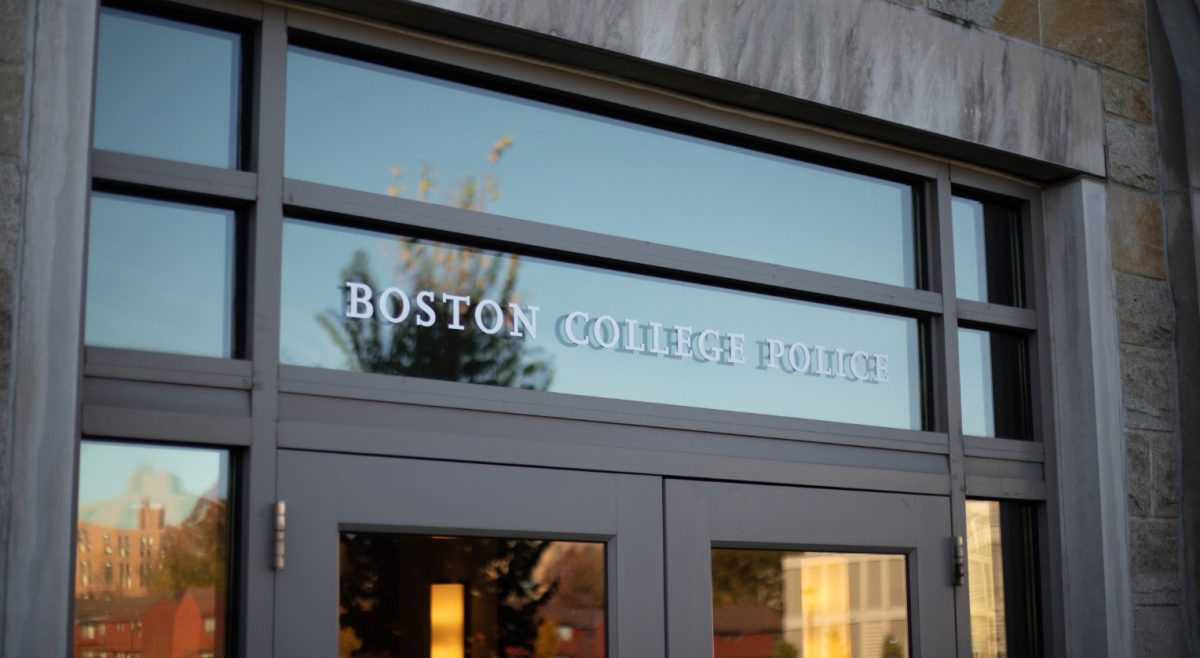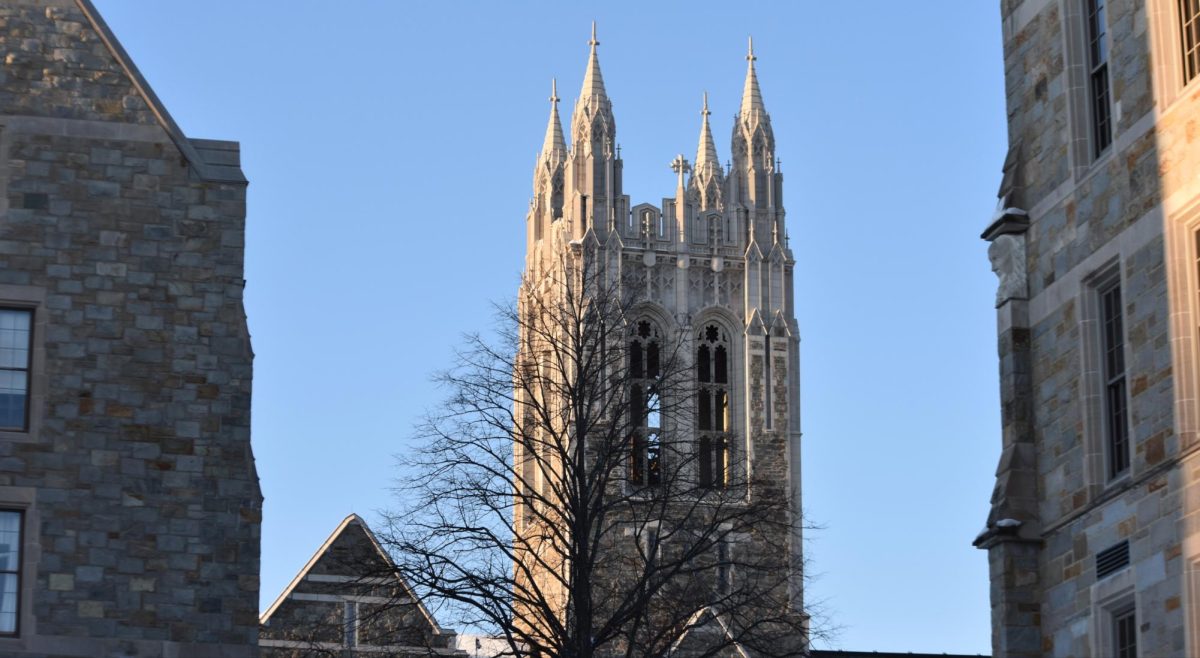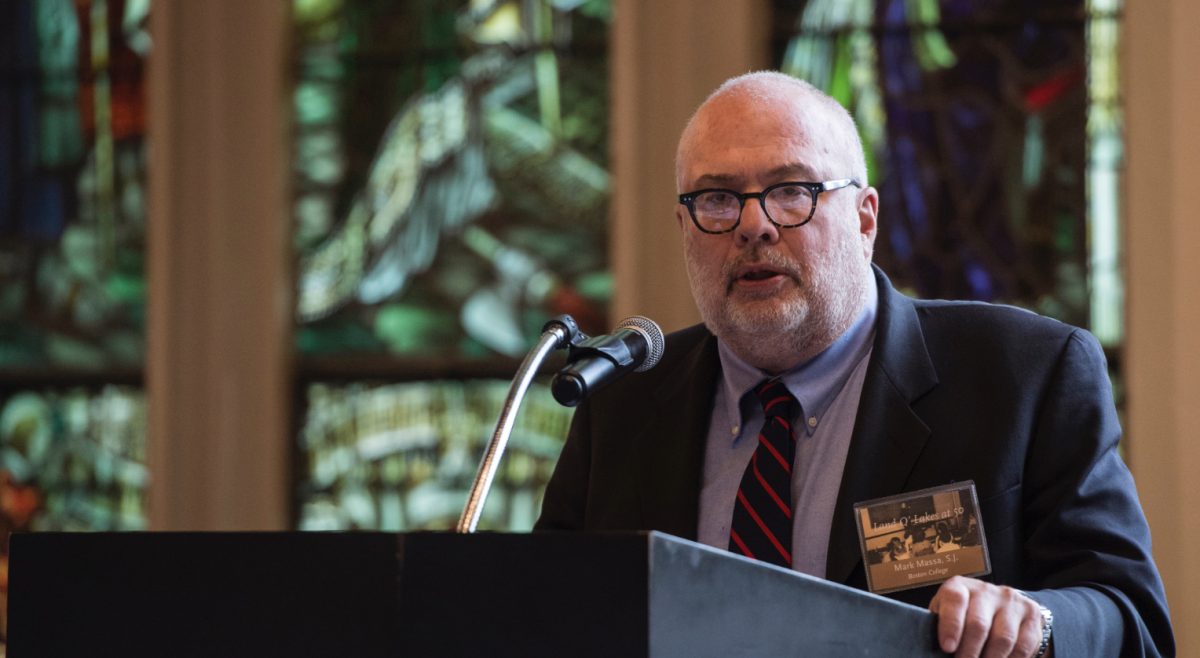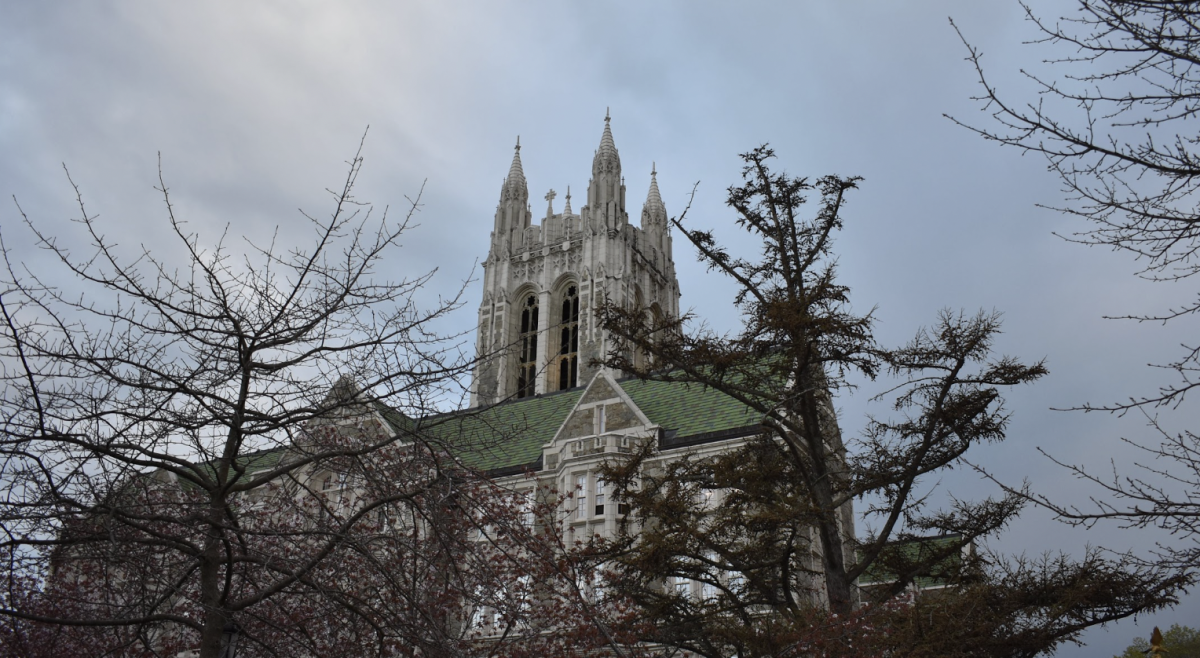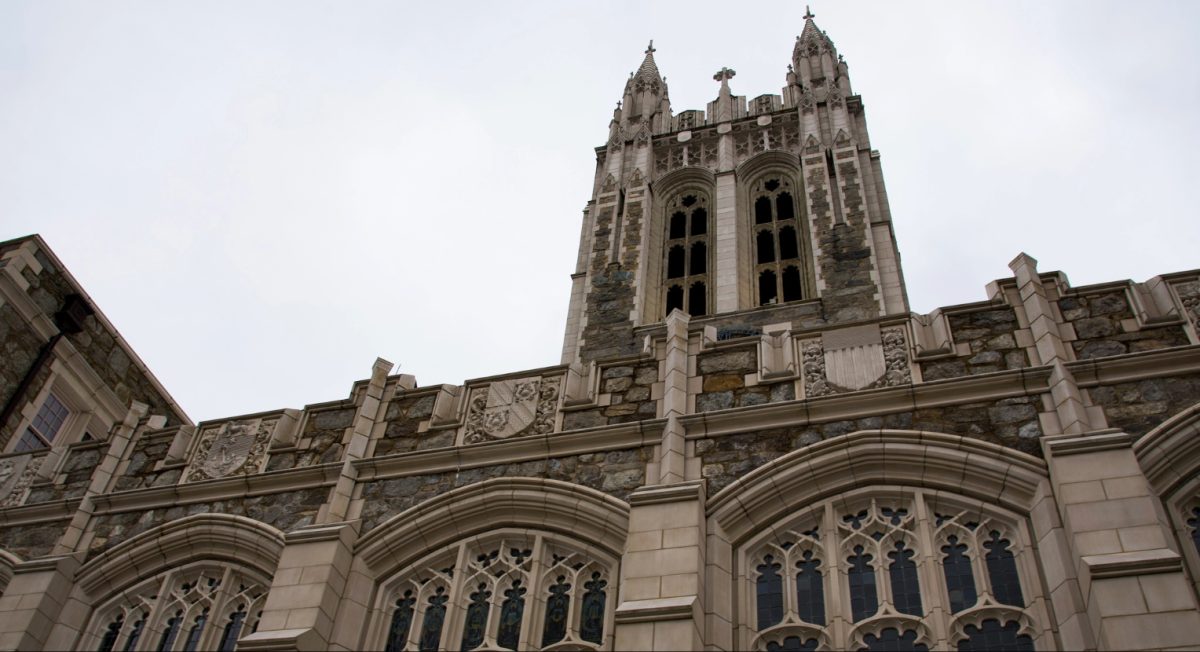Early last week, students and faculty scrambled to put together a makeshift exhibition space on the fourth floor of Devlin Hall-a response to the recent closing of the student art gallery in the basement of Bapst Library. It has been brought to the attention of the University that the Bapst art gallery space is not compliant with the Americans with Disabilities Act (ADA), forcing the University to close the space due to lack of accessibility.
The most recent exhibit to be displaced was Wunderkammer, featuring the work of students from two courses: professor Sheila Gallagher’s issues and approaches to studio art and Rev. Jeremy Clarke, S.J.’s Asia in the World II: 1800 to the Present.
“This is what happens when the Bapst Student Gallery closes,” Gallagher said, motioning around her as she walked up and down the narrow hallway of Devlin, trying to organize last-minute hangings of the students’ pieces.
“This is not adequate space,” Clarke said at the opening of the exhibit Wednesday evening. “The fire marshal even had concerns that this was a fire hazard.”
Aside from being a safety issue, the movement of the exhibit to Devlin has furthered a larger concern among students and faculty members, both within the fine arts department and among the general artistic community, that Boston College currently does not have adequate exhibition space for students and professors to showcase their work.
The Bapst Student Gallery, the first formal exhibit area on campus dedicated to student artists, was implemented in 2004 after Gallagher and members of the Art Club recognized a need to have such a space for students. Up until its recent closing, the gallery was curated by the Art Club, and the library assisted in arranging the exhibits and maintaining the space. In a letter to Claude Cernuschi, chair of the fine arts department, Gallagher mentioned that members of the department have noted the physical limitations of the Bapst gallery in the past, yet the issue had not been directly addressed until last week.
“In 2010 myself and Adeane Bregman worked with a student, Tyson Jang, to draw up extensive architectural plans, which proposed improvements and locations for a handicapped elevator,” Gallagher wrote. “Besides access, the Bapst space has other limitations including lack of security, insufficient lighting, and awkward circulation.”
The closure of the Bapst gallery has prompted the administration to examine currently existing spaces, and how the issue will be addressed in future architectural planning of the University.
“A University-wide committee consisting of the space planning office, academic representatives and the arts council is scheduled to meet in the next couple of weeks to resolve the immediate issue of finding the best accessible locations on campus to display art,” said Kelli Armstrong, vice president for planning and assessment, in an email. David Quigley, dean of the college and graduate school of Arts & Sciences, has been working with Gene McMahon, associate dean of finance and administration for A&S, to plan both short-term and long-term solutions. Although plans have not been finalized, one possibility includes utilization of the space currently occupied by the McMullen Museum, which is anticipated to move to Brighton Campus within the next few years, according to Quigley. The current spaces that exist on campus through University Libraries include the level one and level three galleries in O’Neill, along with a space in the Theology and Ministry Library (TML), which is usually reserved for members within the School of Theology and Ministry. Although the libraries have no control over the closing of the Bapst gallery, they will continue collaborating with student groups and academic departments.
“We try to be a partner whenever we can,” said Scott Britton, associate University librarian. “We love having people come to us with ideas, whether it’s to co-sponsor something or to provide space.” University Librarian Thomas Wall added that the arts play an important role at the University, and that the libraries will continue to do whatever they can to promote their display. “We do our part-a very small part-but we like to be seen as a place where art is appreciated and an open space for student expression,” he said.
Kevin Tringale, exhibits specialist for Bapst Art Library, previously worked on the Student Art Gallery, and is currently responsible for organizing and coordinating exhibits within O’Neill as well as TML. Tringale noted that the University Libraries only have so much space, and the closing of the Bapst gallery not only affects the fine arts department, but it also it impacts the libraries themselves and any club or organization on campus that seeks gallery space. The level one gallery in O’Neill has already been fully booked for the fall semester of 2014-with space being even more limited now, Tringale hopes that more attention will be focused on the creation of a new student gallery, noting that it’s a valuable learning experience for the students and faculty involved.
“I’ve been working here a long time, and I’ve never seen any change of policy in [exhibit space],” he said. “Hopefully this will begin some dialogue with the University as to what they can offer.”
Gallagher also explained the need to have a centralized department gallery, since studios are currently located in different buildings both on and off campus. In addition, a new space would encourage the possibility of inviting contemporary artists to exhibit their work in a space that is equivalent to or approaching professional museum standards.
“I venture to say that we are the only university I know of where there is not a single space at the University where we as faculty members can invite professionals in our field to exhibit their work here,” Gallagher said, citing the Jewett Gallery at Wellesley College as a good model to follow for future establishments at BC. In the aforementioned letter to Cernuschi, Gallagher detailed guidelines for creating efficient exhibition space-a publicly visible and accessible location that is capable of being locked, along with features such as adjustable track lighting and ceilings over 10 feet tall.
“We need space that’s devoted to exhibitions,” Gallagher added. “We don’t need a hallway. We’re not in the business of decoration. This is not about finding a place where a student can put up a poster in the Chocolate Bar. It’s about creating discourse around contemporary art practice, and also-very importantly-having a site for cultural programming that comes from students.”
Aside from the short-term consequences resulting from the closure of the Bapst gallery, a pre-professional training opportunity is also lost, as the exhibition space allowed students to prepare for work in related arts fields. Sarah Webber, president of the Art Club in 2012 and A&S ’14, reflected on her experience working on the art shows in Bapst, and on what the loss means for future Art Club members.
“I think it’s been really powerful and helpful to understand not only how to exhibit my work, but also how to curate a show,” she said. “I think that’s a very practical skill for art students to learn and is something that can be applied in future jobs and other positions.” The Bapst space was essential to students such as Webber and current Art Club president Vivian Phan, biochemistry major and A&S ’15, who are not students in the fine arts department and therefore lack the same resources, and wouldn’t have an audience for their artwork otherwise.
“The Art Club’s mission on campus is to bring art to the general population on campus beyond the students that are fine arts majors or minors,” Phan explained. While the closing of the Bapst Student Gallery came as a shock to Phan and other Art Club members, she understood the University’s decision to close the space. “The whole point is to bring arts to everyone, and if we’re excluding students, that’s a problem,” she said. “We just weren’t aware of it, because when you’re given a space on campus, you assume that everything’s good to go.”
Students such as Phan and Webber, along with faculty members such as Gallagher, are still frustrated by the apparent lack of representation for the visual arts on campus. Gallagher posed several reasons for the absence, such as the small staff of the fine arts department that services over a thousand students. Going forward, however, she feels that the visual arts must be made a higher priority for the University.
“Frankly, it’s curious and bewildering to me why more attention has not been paid to the arts,” she said. “Especially the visual arts, fits so perfectly with the Jesuit mission of reflection and imagination, creation and creativity, and creating for others.”
As a professor in the history department, Quigley offered insight into why BC seems to be lagging behind other universities in terms of visual display of the arts, in addition to limited space resources.
“As a historian, one thing that I point to in comparison to other universities is that they had well-established arts departments or schools of the arts for much of the 20th century,” he said. “The arts, as academic departments, are fairly recent phenomena at Boston College, and part of the explanation is that the arts came fairly late to BC. We are continuing to catch up to the creativity and imagination of our students and faculty.”
Catching up will be a more immediate concern to accommodate the closing of the Bapst Student Gallery, and Webber noted the need for a joint effort between the administration and the students.
“I think there could be a painting right behind you on the wall, and why not?” she said. “I think [the University] doesn’t take the most open approach to finding ways to integrate art into our studies, where I see a lot of room for that to happen. I know they have programs like Athletics that bring in as much money as they put into them, and I think they could find a way for that to work with the arts. They haven’t been motivated to do so yet, and I think that will happen when the students are motivated.”

